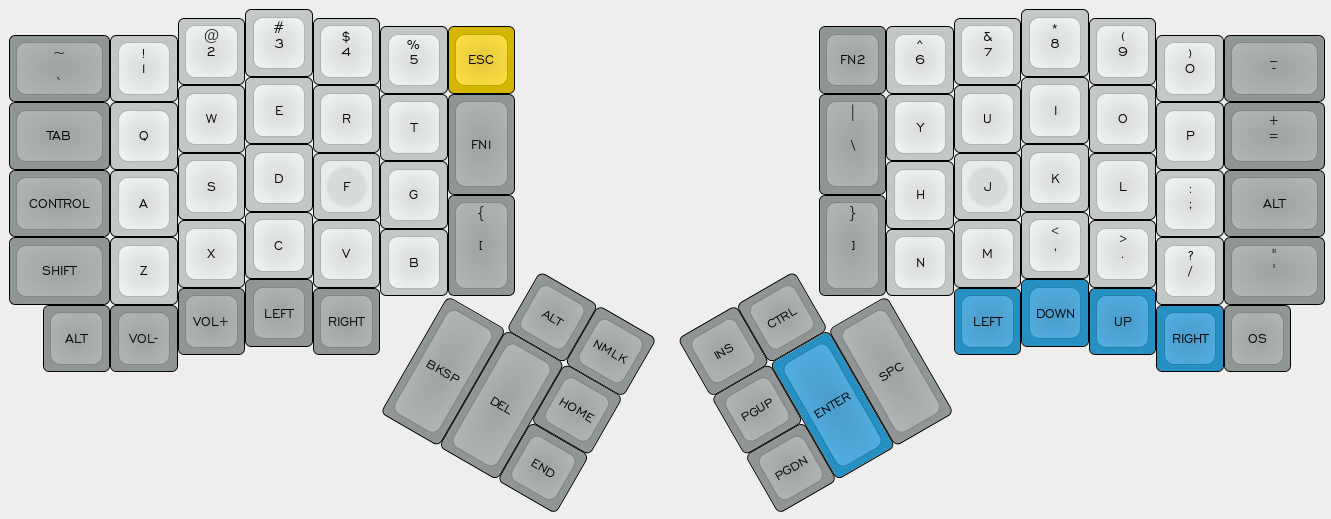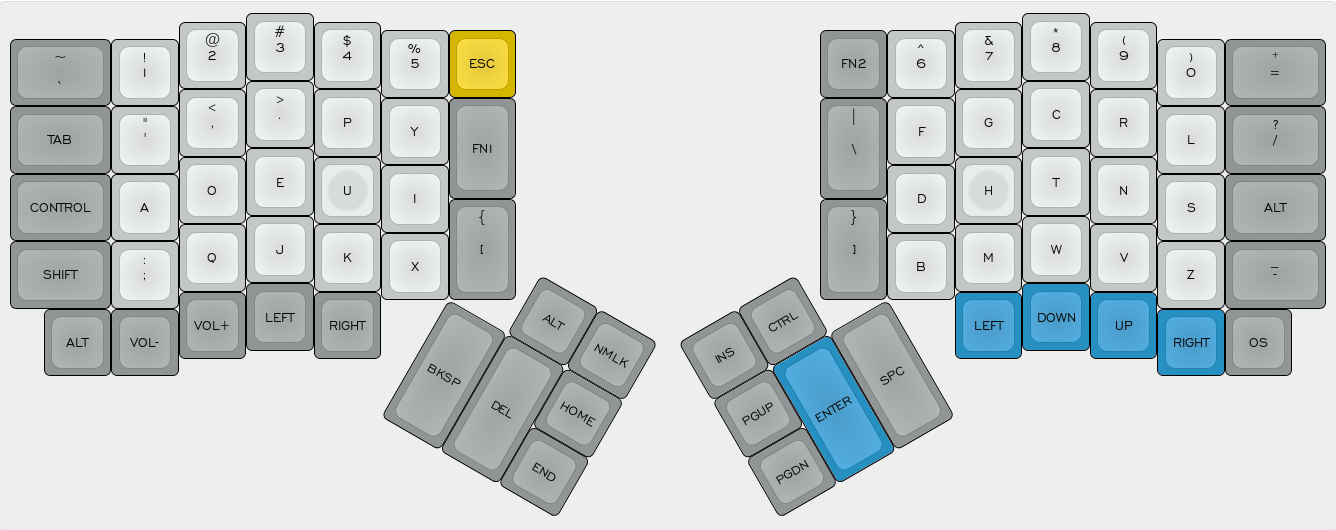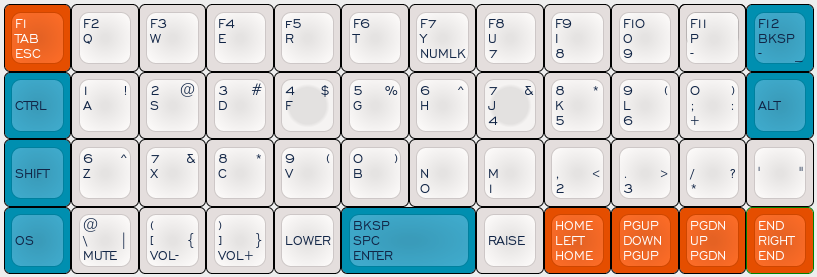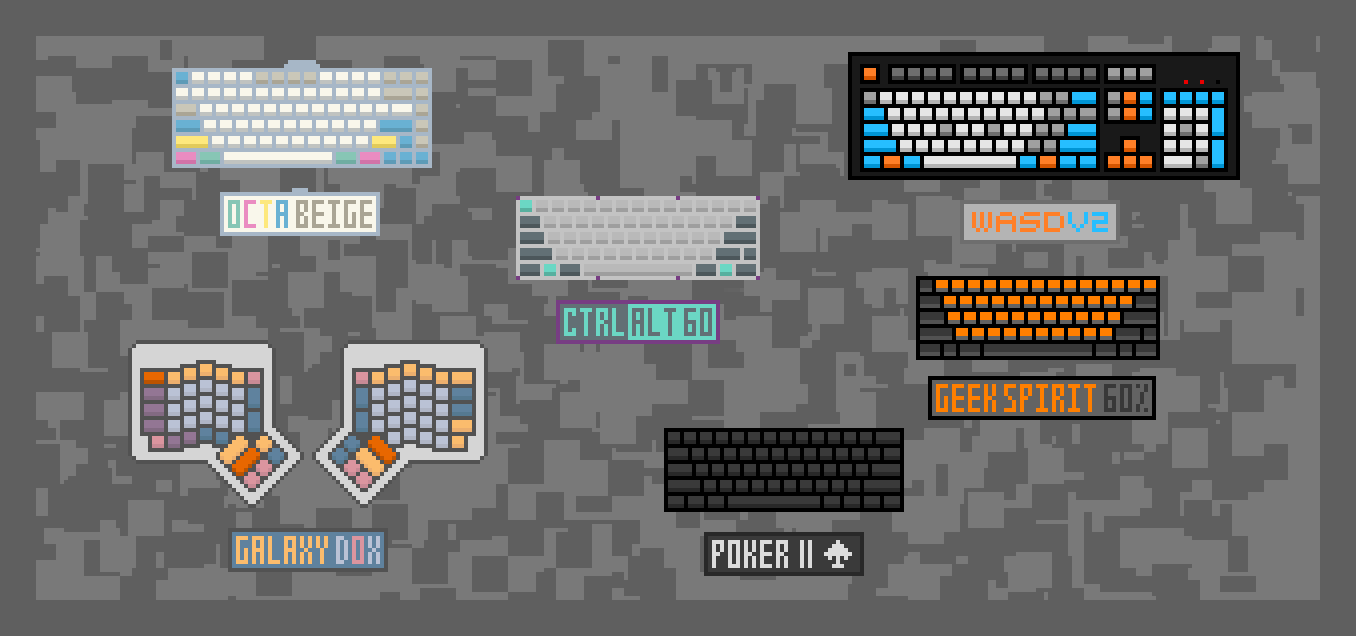Mar. 5th's run: 5 miles in 00:51. The shoe laces are irritating me more than ever: I just couldn't get them to feel consistant. 🤔
Mar. 8th's run: 6 miles in 00:55. We're getting there. 😆 Also I just noticed Mastodon actually autodetects language of the post.
My Keyboards 2018 Edition
As part of my effort to tick off the last remaining item on my site roadmap, I read through some old keyboard-related posts from my WordPress blog and decided to give them an uplift to include more recent experiments.
The First Crispy Clack
My very first mechanical keyboard is a WASD v2 104 key with Cherry MX Blue switches that I got in 2014. I picked WASD mainly because of their keyboards' minimal look and keycap customization options. I also got my first 60% in 2014, a Poker II with Cherry MX Brown. Switch selection were more limited back then, seemingly because of potential issues with Cherry's patent. Of course, switch choices is only limited if we restrict ourselves to Cherry MX compatibles, but most alternatives (Matias, Topre, buckling spring to name a few) were even harder to come by in an commonly available package that I liked.
A GH60 based 60% that I frankensteined together became my main keyboard at first. I used Cherry MX Clear switches with 62g springs (ErgoClear) on them, mostly for the fun factor instead of preference. I also found myself tinkering with the layout a lot more often than when I had the Poker II. As great as Poker II's built-in macros mapping sounds, I could never remember all the steps without taking a moment to peruse the manual. I also found myself setting macros up and yet completely forget about them ever since. With GH60's firmware, at the very least I have the configuration files to remind me of the new bindings I set up. Even with this shiny new toy though, my early experiments with keyboard layouts still had only limited success. The layout of a 60% is too standard in my opinion to justify significant changes (while maintaining QWERTY layout), i.e. there isn't really a good location to move Enter to. The few tweaks I ended up making were numpad/function key mapping and swapping out Caps Lock for Control, which at best makes my GH60 on par with any random keyboard with xkb.
On a side note, I once aspired to collect keyboards of all form factors, but soon discovered it to be a highly impractical and expansive exercise. Thus far among the more common layouts, I either owned or tried 104 key, 96 key, 87 key, 75 key, 60 key, and 40 key keyboards. Majority of these differs very little experience wise for me, except for 60% or 40%, where a bit of creativity is required to fit all the desired keys.
ErgoDox and Planck
The first keyboard ever to trigger me to give deeper thoughts into my keyboard layout is the ErgoDox. The ErgoDox boasts a layout drastically different from traditional keyboards, and because of this, offers great flexibility over key placements: I can immediately spot seven sensible locations for the Enter key (original pinky location, four 2u keys at the thumb clusters and the lower two 1.5u vertical keys in the center). I've been using ErgoDox almost exclusively since 2015, and have grown to like it even more as I started using Emacs - having access to both Control and Alt/Meta key on the home row just feels awesome.

I still feel I am under-utilizing the keyboard's capabilities though. As you might tell, I don't know what to do with some of the thumb cluster keys. I currently have three extra layers set up: one for function keys, one for numpad, and another for a modified Dvorak layout. I haven't spend too much time on the Dvorak layer yet, but I am curious about potential benefits of decreased finger motion. Speaking of ergonomics, a perhaps uninteded benefit of ErgoDox's design is that it frees up the center of my desk, so that I can still read and write normally without a super deep desk.

Planck is another keyboard that I've taken some thoughts designing layout for. It is pretty surprising what a 40% board is actually capable of. However, using Planck is a lot less comfortable just because of how small it is - ErgoDox on the other hand allows me to rest my arms in more natural positions, instead of cramming my hands together. That being said, I would imagine a Let's Split - basically a Planck split in halves - to work fairly well.

Keycap Craze
Ever since I discovered Geekhack, I would routinely refresh the groupbuy or interest check section for new keycap sets that other users designed. I gradually went from sets with flashy colors to those with a more muted and uniform look. I also prefer uniform keycap profiles (like DSA) with text legends than those with height gradients and graphical legends, although I find it really hard to appreciate blank keycaps. Getting a full set of keycaps with matching legends for ErgoDox is certainly no easy task (unlike Planck which is almost entirely consisted of 1u keys), and all these quirks I have made keycap shopping increasingly difficult.
My Own Keyboard/Layout
I've thought about creating my own keyboard occasionally. As perfect as ErgoDox may seem, it is somewhat bulky, and I find the thumb cluster a bit hard to reach. For quite some time I used C-Home and C-End to move to top/bottom of a file in Emacs, and that caused pain in my thumb joint as I need to stretch hard to reach both keys (that went away when I found M-< and M-> though). A slim down version of ErgoDox with more compact thumb clusters might just be the perfect keyboard. By the way, I have never before find wireless keyboard necessary in any way, but since ErgoDox features a split design, a wireless version of it can be used while lying down Nintendo-Switch-style, which would be pretty awesome.
Since I started using Emacs as my main editor, I've been taking statistics of my key-presses with keyfreq. When I have gathered enough data, I might look into customizing my layout even further to suit my needs.
Pixel Art
Like many Geekhackers out there, I made a pixel art of my keyboards and used it as my Geekhack signature.


Drawing pixel art for keyboard is a fairly interesting exercise, since it is impossible to get the ratios exactly right, I needed to strike a balance between accuracy and simplicity. I will give this a long due update when I have time.
Mar. 9th: 6 miles in 00:53.
Mar. 10th: 6 miles in 00:54.
Mar. 11th: 6 miles in 00:53.
Mar. 13th: 6 miles in 00:55.
Mar. 14th: 6 miles in 00:53.
Mar. 16th: 6 miles in 00:54.
Mar. 20th: 2 miles in 00:17.
I felt running only in the CCW direction caused my shoes to be unevenly weared, thus causing the weird shoelace issue.
Mar 22nd: 4 miles in 00:37.
Mar 23rd: 4 miles in 00:38.
We should have Akinator for large code bases/programming languages, i.e. it will point me to readily avaliable libraries that does what I want to avoid reinventing the wheel.